Facial Recognition
by Andrew Maerkle
You got so excited by the Snapchat dog-ears filter; Japanese kids had that technology in the 90s. In Tokyo, selfie culture has a long history, one photographers ignore at their peril

View of “The Self-Portraits of Yasumasa Morimura.” National Museum of Art, Osaka. Photo: Kazuo Fukunaga.
One evening last fall, I was out in the neighborhood when I bumped into Yasumasa Morimura. He was in Tokyo for meetings, and he asked me for my opinion on potential titles for a film he was producing, based on the exhibition he had held earlier in the year at the National Museum of Art in Osaka. Among the ideas he was considering were “The Selfie,” or just “Selfie.” My first reaction was to laugh it off as a gag. But Morimura’s humor is absolutely serious — this is, after all, the artist whose many photographic reinterpretations of Marilyn Monroe’s indelible upskirt image from The Seven Year Itch include one in which his own erect penis extends from beneath the billowing skirt folds.
Morimura has been taking selfies long before that English slang was coined, and if there was a hint of opportunism in his appropriation of faddish language, there also seemed to be a desire to remind people that the “selfie” forms part of a long tradition in art history. Of course, Morimura’s selfie has never been solely about himself. It’s always been an investigation into the multiple selves that exist simultaneously within us — the van Gogh or Warhol within each artist; the female within the male, and vice versa — which can lie dormant for years, only to emerge under the most unforeseen circumstances, even, in some cases, after death. Though he has been making self-portraits in the guise of other works of art since the 1980s, they have taken on more significance since the rise of template-based mobile imaging apps like Instagram and Snapchat, with their focus on visibility, connectivity, and, by extension, recursive self-affirmation.
It is no accident that the show in Osaka, the artist’s first at an institution in his hometown, should have focused on the self-portrait. Interweaving new and old works, as well as new interpretations of old themes, the exhibition was an apt recapitulation of Morimura’s career, further couched within the framework of a biographical self-examination. It began with a recreation of a three-person show, held in 1985 at Gallery 16 in Kyoto, where Morimura debuted his breakthrough photograph, Portrait (Van Gogh), in which the artist appears in the place of the Dutch painter’s Self-Portrait with Bandaged Ear and Pipe (1889). Morimura had started out as a painter before gravitating to photography, when, at age 34, he hit upon the idea of combining the two. The success of this work, which could almost pass for a seamless digital alteration, is that everything in it — from Morimura’s face, bandage and hat to the solid red background — was made to look as if it were painted, and then shot with flat lighting so that all the elements would collapse back into two dimensions, leaving only subtle indexes, like the glint in the artist’s eyes, of real life.
This playing of different media against one another is representative of Morimura’s best works. They momentarily pop the relationship between the “real” and its representation out of joint, then slide it back together in unsettling ways. It recurs in a new take on van Gogh, Self-Portraits through Art History (Van Gogh’s Room) (2016), in which Morimura has inserted himself into van Gogh’s bedroom in Arles. The set that Morimura built was constructed such that everything appears foreshortened in the final photograph, but look at the floorboards: the impressionistic flurries of purple-toned brushstrokes in van Gogh’s original painting have been recreated as large, arbitrary marks applied to the “real” flooring of the life-size set, then reduced by Morimura’s camera back to two dimensions so that they would once again express the notion of “floorness.”
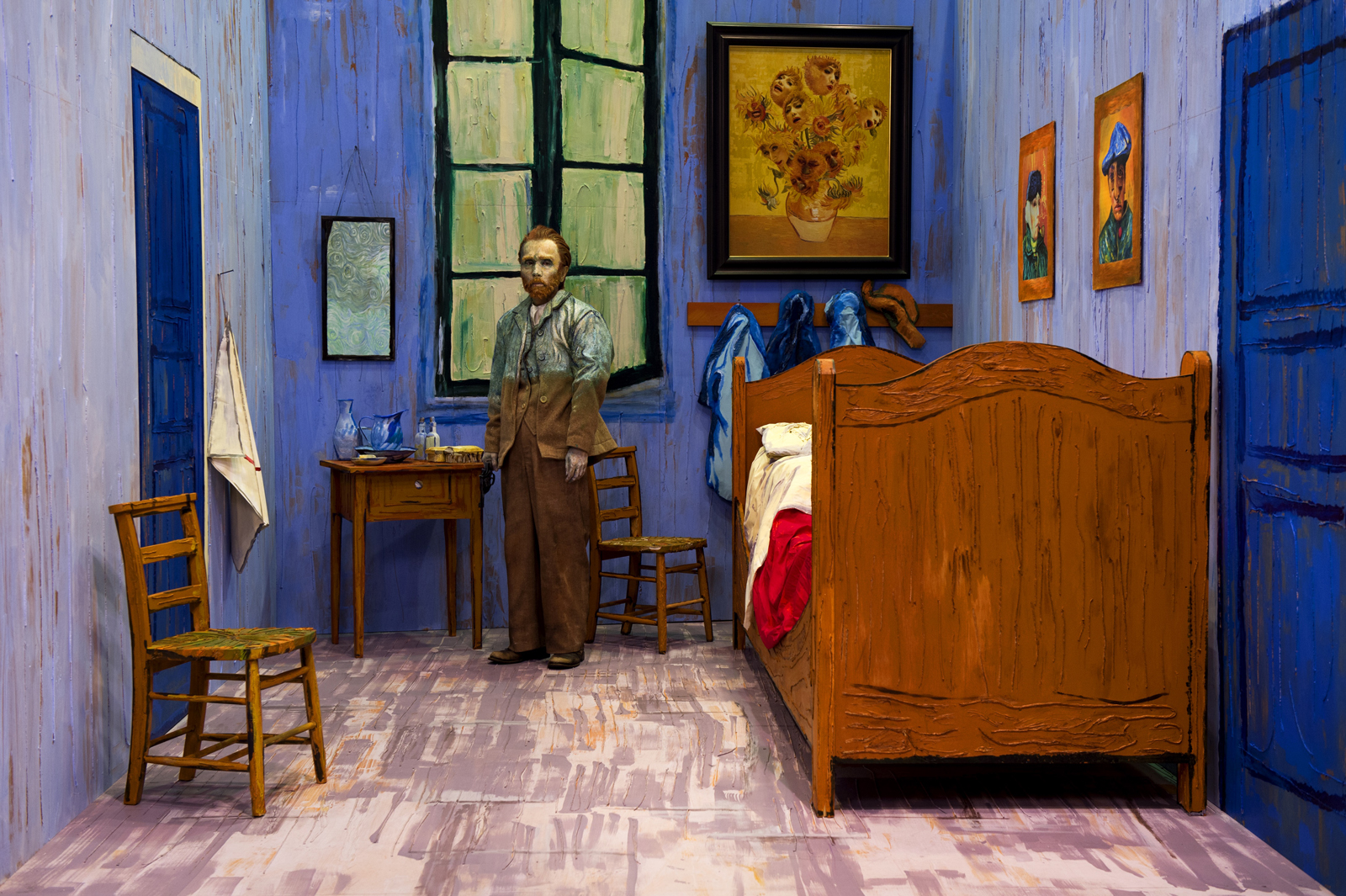
Morimura effortlessly toggles between multiple roles and genders, and this performative aspect alone is enough to sustain a cursory interest even in works that otherwise fall flat — such as his new, slightly undercooked series based on self-portraits by early 20th-century Japanese painters. The work that really jolted the exhibition into the contemporary moment, though, was installed innocuously at the back end of the mazelike arrangement of galleries. Made in 1988, Doublonnage (Marcel) is a recreation of Man Ray’s portrait of Marcel Duchamp posing as his alter ego, Rrose Sélavy. Shot in color against a turquoise backdrop, it shows the Rrose Sélavy figure, face whitened, lips rouged, staring impassively at the lens. But certain details are, oddly, doubled. Instead of one hat, there are two, with the same “tribal modern” decorations around the band, perched one on top of the other. And instead of a single pair of hands, celadon complexioned, raised to chin and cheek in a gesture of coy femininity, there is a second pair, masculine and tanned, reaching from behind the black fur coat to grip the other by the wrists. So different are the skin tones — highly gendered, even in today’s Japan — that it’s hard to tell whether all four hands belong to Morimura, or whether a woman is reaching up from the bottom of the frame. A compressed mise-en-abyme, this work cuts to the freakishness of Morimura’s conceit, in which the self-portrait is an uncanny mirror, monstrous and alienating in its doubleness, and the viewer is constantly reminded that something else exists backstage.

For Morimura, the reflection is the space where otherness emerges. The mirror becomes the inframince — Duchamp’s term for a vanishingly small differential that can serve as a channel to an unseen dimension — whereby the difference between self and other is reduced to the mere surface of a glass. This is, when you think about it, also the underlying dynamic of the post-workout selfie, or the outdoor yoga selfie, or the dick pic, or even the obligatory foodporn snapshot. (Here one recalls Morimura’s take on Yasuzo Nojima’s haunting photogravure still-life, from 1930, of the anthropomorphic citrus fruit known as busshukan, or Buddha’s hand.) All those smartphone snaps express a morbid overidentification with the image of the self, precisely because it is already alienated from one’s own reality. If such images circulate at the level of aspirational projection, instead of critical interrogation, that may be a marker of narcissism more than anything else. But whether narcissistic or not, the implicit question asked by self-portrait and selfie alike is: Is this not me?
Around the time I bumped into Morimura, work by Hiroshi Sugimoto — whose “Dioramas” series, begun in 1974, anticipates Morimura’s practice — was on view at the newly rebranded Tokyo Photographic Art Museum (formerly the Tokyo Metropolitan Museum of Photography). The museum was celebrating its 20th anniversary, and the refurbishment of its facilities, with a revised version of the exhibition Sugimoto debuted at Paris’s Palais de Tokyo in 2014: “Aujourd’hui, le monde est mort [Lost Human Genetic Archive],” which envisioned a time after the end of humanity. Presented with a gallery of his more famous long exposure photographs, “Lost Human Genetic Archive” was an installation of found materials, ranging from hundred-million-year-old fossils to Paleolithic tools, cuneiform tablets, albums of Piranesi etchings, ancient packets of space food, and a 1987 Macintosh SE computer. Also on view were what might loosely be called assemblages — a pair of vintage milk crates filled with Viagra tablets, or a recreation of Duchamp’s Étant donnés using a lifelike sex doll — made by Sugimoto himself. The artifacts were arrayed in a warren of cabinet-like presentations reflecting the lives of 33 characters — amongst them an astronaut, a contemporary artist, a fisherman, a geneticist — who each in their own way had contributed to the world’s end, as announced by accompanying short texts, handwritten on loose sheets of paper.
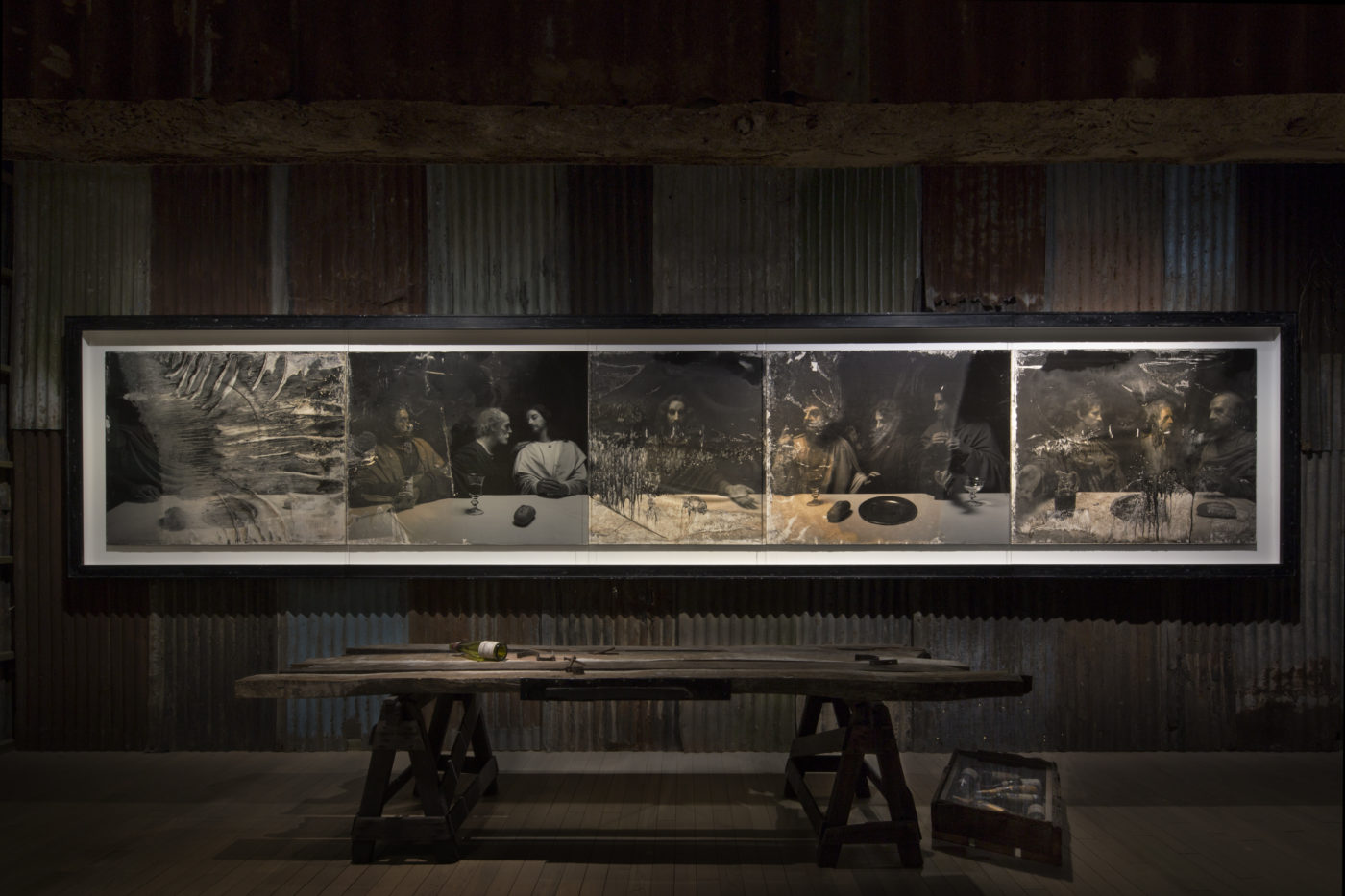
Turning to the world-famous Sugimoto to get people excited again about the museum, which is shoehorned into the backside of a massive dining, retail, and office complex, made perfect sense. Still, when I saw the exhibition on opening night, amid throngs of guests in eveningwear, I thought it was tacky and self-indulgent, overly reliant on theatrical lighting and shorthand signifiers of historicity. Sugimoto’s models for this post-apocalyptic display were the early Renaissance cabinets of curiosities and the tokonoma, the raised alcove in traditional Japanese architecture used for exhibiting objets d’art and flower arrangements. But its aged scrap-wood panels, and corrugated metal sheets lining the walls, made it feel more like a mix between a pretentious antique fair, concept restaurant, and theme park — not unlike the famous ramen museum in Yokohama, where a subterranean recreation of a postwar, eternally twilit Japanese cityscape is the engine for selling “curated” takes on noodle soup.
On my second visit, around 4pm Japan time on November 9, 2016, Donald Trump had hit 266 electoral votes, and I knew that when I left he would win the election. The timing was coincidental — I was headed to a speaking engagement nearby — but it was surreal to walk through an imaginary visualization of the world’s end at the exact moment the world as we knew it seemed to be ending. New details leapt out at me, such as the “Jap Hunting License,” from Iwo Jima, in a red velvet case placed beneath a carte de visite of Karl Marx. My head reeled when I reentered the space of the “Politician,” which featured vintage covers of Time: De Gaulle and Churchill in 1941, Kennedy in 1960, and then Donald Trump himself, on a cover from August 2015, captioned “Deal With It.” It was all too easy to imagine Trump speaking the words of Sugimoto’s accompanying text: “I was foolish to promise citizens a better tomorrow. I was only vaguely aware there were limits to capitalist extended reproduction.... Then that inevitable day arrived.... Time to pay up tomorrow’s tab. Never thought it would happen during my term.”
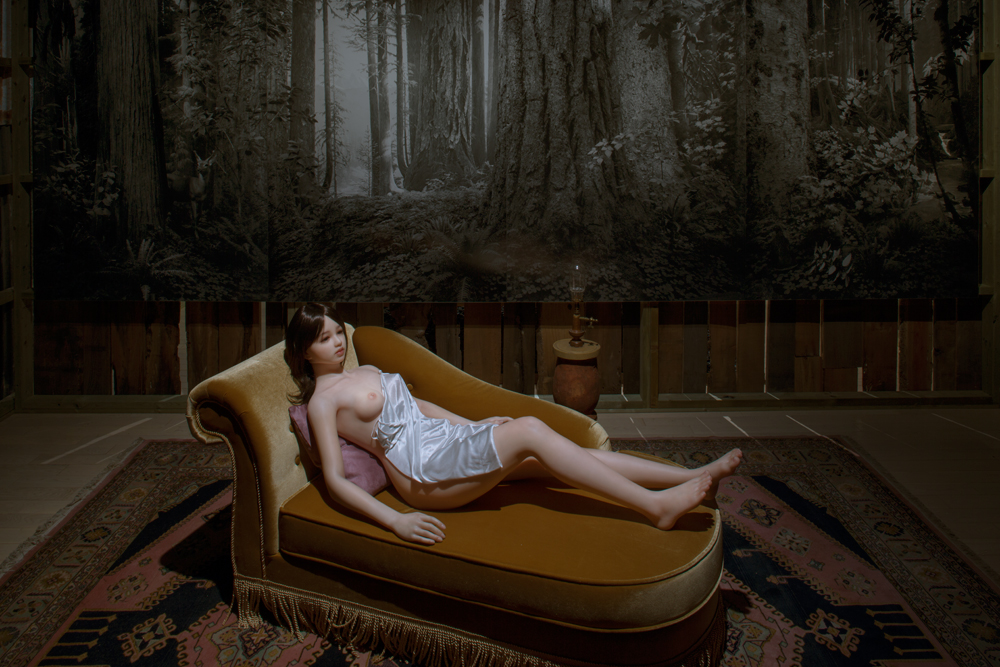
Both photographers with a Duchampian eye for appropriation, Morimura and Sugimoto employ critical languages that are complicit with the institutions of the museum and art history. They have also both reached a stage in their careers at which they can get the best from the institutions with which they work. This is not so for young Japanese artists, who are stunted by the institutional system here. Museums are organizationally handicapped by an entrenched culture of bureaucratic oversight and censorship, and they prioritize blockbuster events that attract exponentially higher gate figures than what contemporary art can deliver. (In 2015, for example, the National Art Center in Tokyo recorded over 660,000 visitors to a show of genre paintings from the Louvre, against some 21,000 visitors to its “Artist File” exhibition of young and mid-career artists.)
It’s therefore increasingly imperative for young artists to break out of the institutional mold if they want to have a voice in Japanese society. The six-member collective Chim↑Pom, founded in 2005, is forging ahead in this regard. Their stunt-based interventions into urban space are necessarily driven by a “look-at-me” attitude — sometimes to powerful effect, as in the videos they shot in the Fukushima exclusion zone in the immediate aftermath of the earthquake, tsunami, and nuclear accident of 2011. But in recent years they have been taking on more complex projects in which they function as both artists and curators. For their latest foray, “So see you again tomorrow, too?,” Chim↑Pom took over a building in Kabukicho, one of Tokyo’s largest red-light districts, which they turned into a massive site-specific environment. Independently funded and produced, the project was ostensibly meant as a response to Tokyo’s scrap-and-build construction cycles, and the urban redevelopment campaign initiated in advance of the 2020 Tokyo Olympics. A dingy mixed-use property slated for demolition, the building itself dated to 1964, the year of Tokyo’s previous Olympics, and the plan was for the works to be destroyed along with it, and the detritus used to create a new exhibition — a scrap-and-build exhibition.
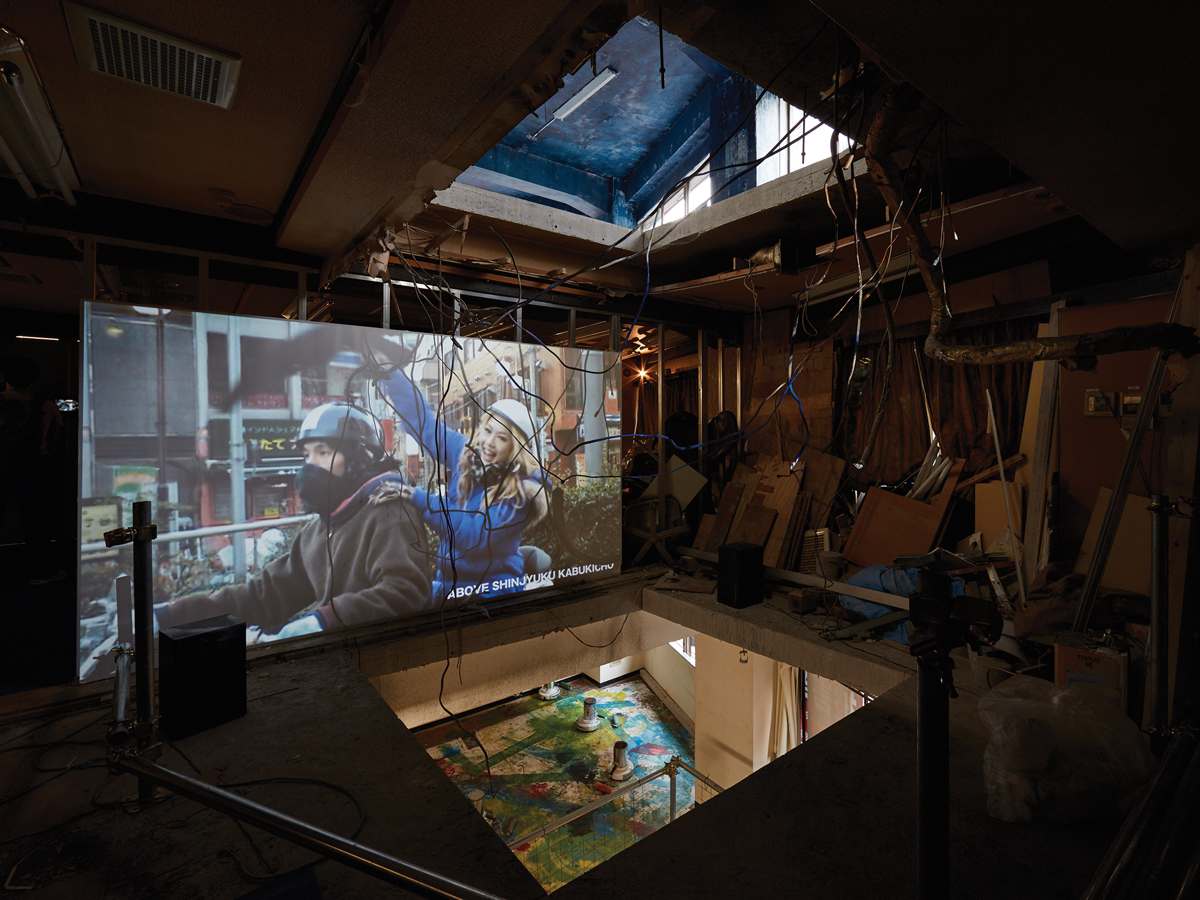
Here, as in Sugimoto’s show, explanatory texts dotted the walls, but the message was garbled in execution. Despite leaning heavily on local atmospherics, the exhibition read more as a site-generated retrospective than a site-specific project as such. Many of the works had been previously displayed in various iterations. The group’s signature video, Black of Death (2007–16), shows them using amplified bird calls to lead flocks of crows around city landmarks, and here it was projected on the third floor, at large scale, amid a cluttered installation of new and old works inspired by Kabukicho. Downstairs from there were the robotic vacuum cleaners of Downtown Paradox (2014),modified with paint cans and rollers to continuously paint the floor in the Olympic colors while “cleaning up” at the same time. Aside from this, the most salient feature was entitled Build-Burger (2016): a series of large square holes that had been cut into the three upper floors, with the rubble assembled in a Big Mac-like pile at the bottom.
Such works operate on an efficient punch-line logic, and they look good on an iPhone screen, of course, which was the implied means of engagement: the holes functioned as a scopic device penetrating the different levels of the exhibition, and upon first encountering it in the fourth-floor “blueprint” room, which had been emptied and coated entirely in cyan paint, few visitors could resist the urge to whip out their devices and snap away into the void. It would have been nice if this intervention, with its wink at Gordon Matta-Clark, could have gone further beyond a phallic assertion of dominance over inert matter. As is, the holes were an Instagram-baiting spectacle, with potentially disastrous consequences for the careless photographer.
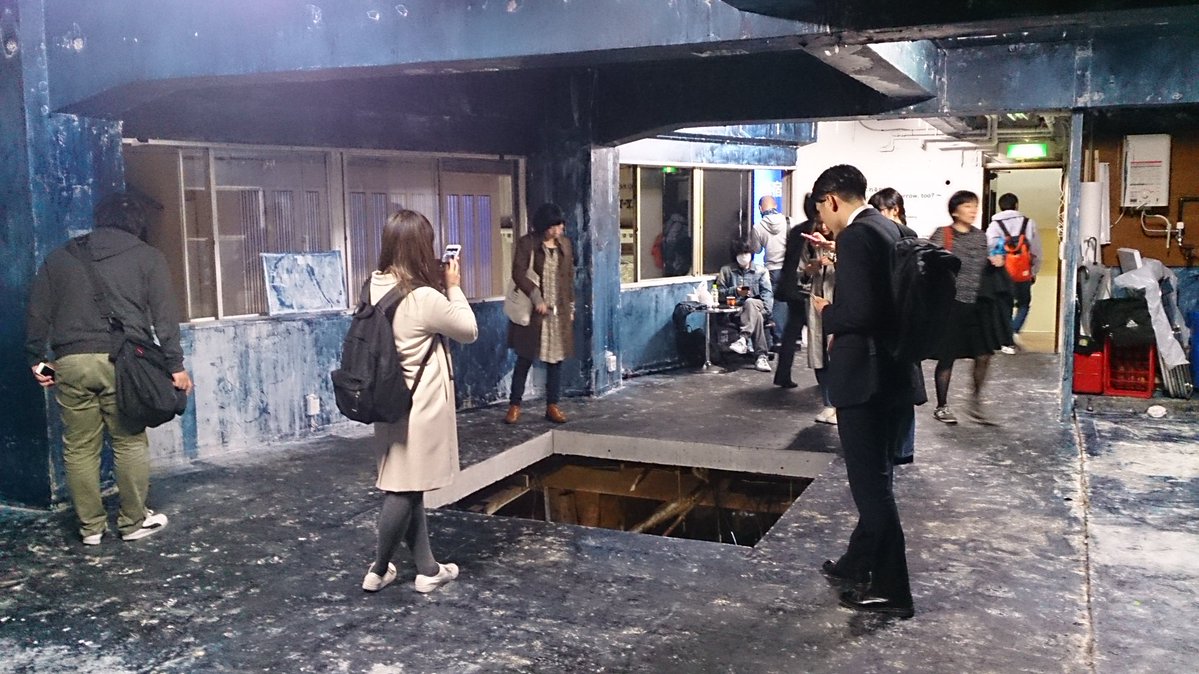
It’s easiest to just “like” or “dislike” and move on. It’s harder to constructively critique Chim↑Pom’s projects, which display incredible initiative and tenacity, and check all the boxes when it comes to using art as a vehicle for provoking establishment values. They also tend to replicate the structures of authority they mean to subvert, from the obscenity of celebrity culture to the pretensions of elitist discourse. In turning a property in Kabukicho into a “found institution” to be symbolically torn down and reinvented, were they opening up new modes of inclusion, or just hacking institutional firewalls to secure their own place in history? Was this an attempt at tearing down and renewing the institution of Chim↑Pom itself, and if so, is that a sign of self-examination or of grandiosity? If anything, the answers will lie in the responses of their peers in the Japanese art scene. But at a time when that scene is increasingly circumscribed by government and corporate appropriation, Chim↑Pom are certainly right to identify space — whether the exclusion zone around Fukushima or the development zone of pre-Olympic Tokyo — as one of the major pressure points in Japan today. The democratic means of contesting space are no longer so effective, if they ever were, and will atrophy without exercise.
Having paid my entry and signed the liability waiver at the makeshift ticket booth on the ground floor, I couldn’t help but sigh at the English-language graffiti, reading “FUCK THE SYSTEM,” that appeared when the elevator door closed before me. Is this part of the show? I wondered, as I was lifted upward. In hindsight, Chim↑Pom, like most self-proclaimed outlaws, know the system better than they let on. Their identification with Tokyo’s super rats, which have grown immune to poison, would not be so apt if they were not able to keep revealing the possibilities for survival to be found in the inframince between breaking the rules and changing them.